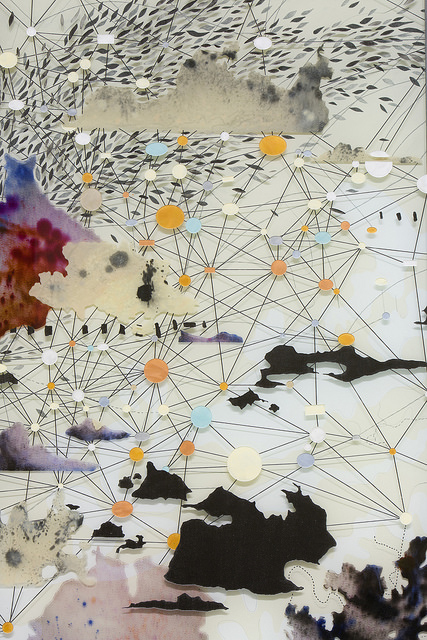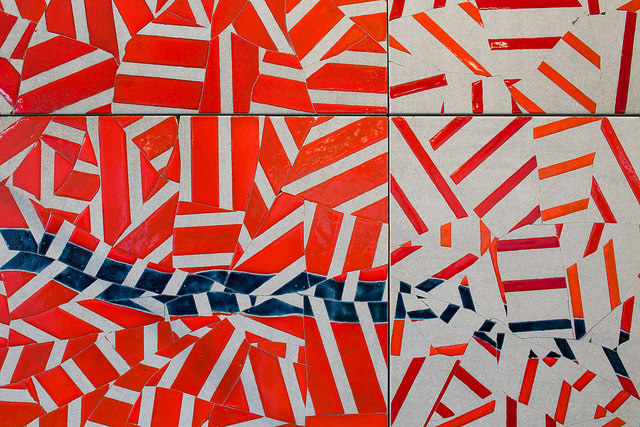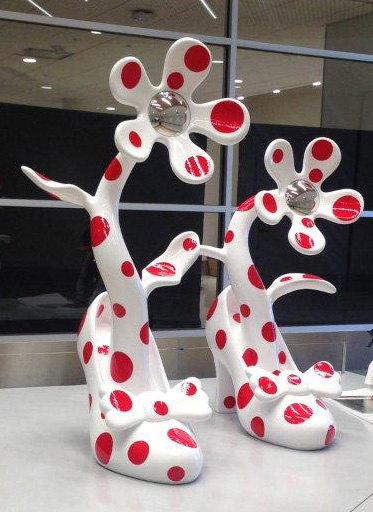The airport is not often a site for the calm contemplation of beautiful things. For most, it’s a place of extreme stress: the stress of securing your ticket, checking your bags, waiting in security, taking off your shoes, pulling out those liquids, locating your gate — and if you’re on time — purchasing overpriced snacks for your snack-less flight.
Or, if you’re like me before a recent transcontinental flight, you’re simply sprinting through the airport in your socks, praying you make to the gate in time.

At the San Francisco International Airport (SFO), the San Francisco Arts Commission (SFAC) strives to make a traveler’s time spent in the airport a little less chaotic and little more contemplative, thanks to artworks funded by the city’s percent-for-art program, San Francisco’s mandate that a public building project expend two percent of its construction cost towards public art.
Two new monumental wall pieces, commissioned by the SFAC from local artists Amy Ellingson and Val Britton, freeze the frenetic activity of the airport into abstract panoramas of color, line and form. Viewed from up close or afar, the works contain pleasant references to constant movement — Britton’s Voyage in particular utilizes an impressive array of material approaches to keep even the most disgruntled victim of flight delays happily immersed in its many intricate details.
Construction work on SFO’s expanded Terminal 3 (the source for these most recent percent-for-art funds) is in its final stages, to be completed shortly before the Thanksgiving holiday rush. Incorporated into the terminal’s new architecture is Ellingson’s Untitled (Large Variation), an adaptation of the artist’s multi-layered and colorful abstract paintings.
Though much of Ellingson’s work is large (think 16-foot-wide works on panel), this mosaic — wider than a basketball court is long — tops all previous efforts. Made in collaboration with Montreal tile fabricators Mosaika, Untitled (Large Variation) covers a slightly curved wall with 60 different colors of tile and seven shades of grout.

Between Terminals 1 and 2, Britton’s piece similarly departs from the artist’s works on paper with the help of commercial fabricators from abroad. Made by Franz Mayer of Munich, Germany, Voyage its horizontal span measures about the width of a basketball court. The 15 laminated glass panels boast etching, ceramic glass melting colors, graphite drawings and lacquer paint in a panoramic collage of flight routes, land masses, circular hubs and weather patterns.
While Britton and Ellingson’s works envelop the weary traveler, smaller pieces throughout the airport interrupt the endless flow of wheelie-suitcase traffic with moments of visual surprise. Riven/River, a new commission from Bay Area ceramic artist Jim Melchert, offers an interpretation of a view travelers might soon have out of their 747’s windows. The crooked path of a “river” of blue stripes crosses a field of red-striped tiles, all cracked and reassembled in a fractured jumble, much like the patterns seen in farmlands from the air.

Nearby, a bizarre sculpture by internationally-renowned Japanese artist Yayoi Kusama titled High Heels for Going to Heaven is sure to become one of the most photographed pieces of art at SFO. Her signature red polka-dots adorn the white plastic sculpture — two high-heeled shoes (the likes of which a giant Minnie Mouse would wear) with cartoonish flowers sprouting from the footbeds. At the center of the rounded plastic petals are highly polished domes of stainless steel, reminiscent of security mirrors and a reminder of the many watchful “eyes” in the airport at large.
And at Terminal 3’s baggage claim, a series of six posters by Hayward-based artist Lordy Rodriguez presents distorted versions of San Francisco neighborhoods mapped out by business names and local patterns, some of which are repeated, thoughtfully, in nearby architectural elements. The Strangerland drawings abandon accurate mapping for a more joyful approach to signage and color, placing familiar restaurants and bars in the midst lakes and archipelagos.
None of the recently-installed artworks at SFO push the tame boundaries of what is expected from committee-approved public art — though Kusama’s sculpture is definitely weird — but for the purposes of alleviating the pressures of travel, they serve that purpose well. The public art at SFO is the city’s most valuable collection outside of the Fine Arts Museums of San Francisco, a point of pride for those at the SFAC who persevere through years of open calls, panel decisions and negotiations with architects and contractors (often about details as banal as the placement of exit signs). These hard-won commissions provide artists with opportunities to experiment with materials and at scales their individual budgets might never accommodate.
And after the unpleasant stress of removing one’s shoes, the public art at SFO equals a few momentary bright spots in the increasingly demoralizing routine of air travel.